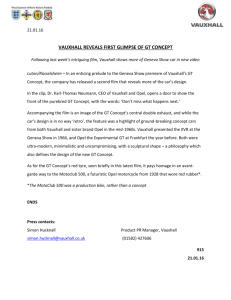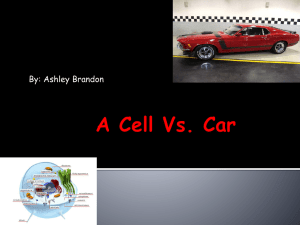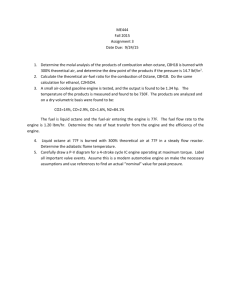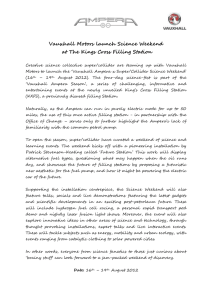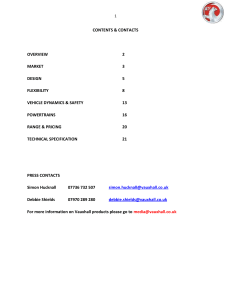FOR IMMEDIATE RELEASE VAUXHALL TO LAUNCH NEW LARGE
advertisement
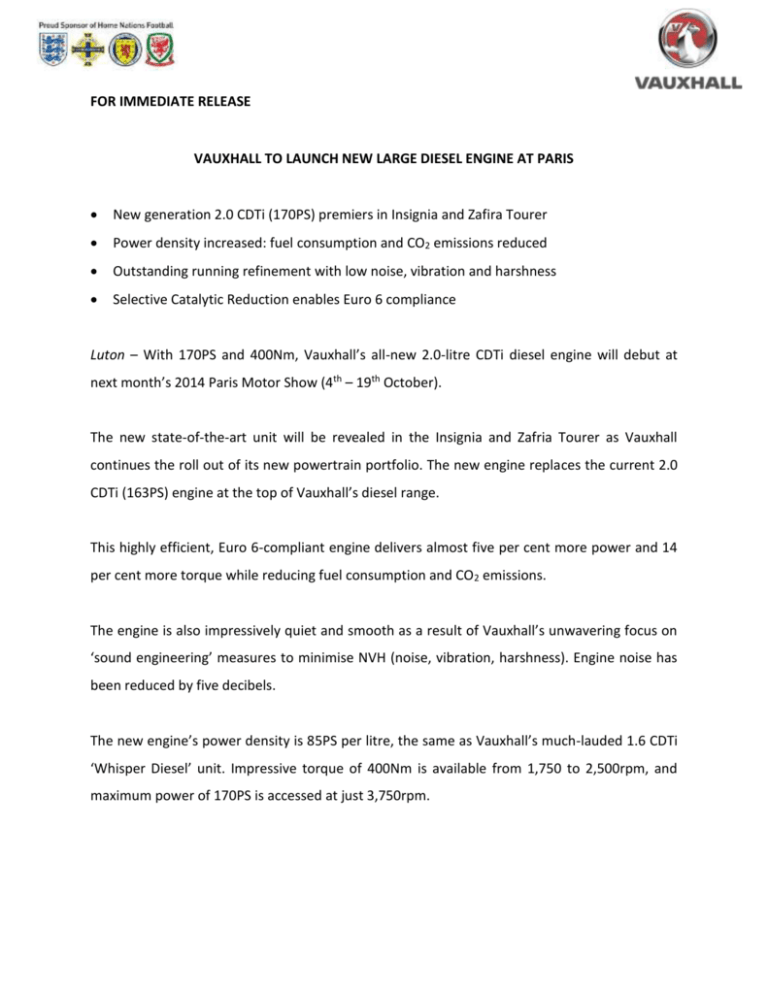
1 FOR IMMEDIATE RELEASE VAUXHALL TO LAUNCH NEW LARGE DIESEL ENGINE AT PARIS New generation 2.0 CDTi (170PS) premiers in Insignia and Zafira Tourer Power density increased: fuel consumption and CO2 emissions reduced Outstanding running refinement with low noise, vibration and harshness Selective Catalytic Reduction enables Euro 6 compliance Luton – With 170PS and 400Nm, Vauxhall’s all-new 2.0-litre CDTi diesel engine will debut at next month’s 2014 Paris Motor Show (4th – 19th October). The new state-of-the-art unit will be revealed in the Insignia and Zafria Tourer as Vauxhall continues the roll out of its new powertrain portfolio. The new engine replaces the current 2.0 CDTi (163PS) engine at the top of Vauxhall’s diesel range. This highly efficient, Euro 6-compliant engine delivers almost five per cent more power and 14 per cent more torque while reducing fuel consumption and CO2 emissions. The engine is also impressively quiet and smooth as a result of Vauxhall’s unwavering focus on ‘sound engineering’ measures to minimise NVH (noise, vibration, harshness). Engine noise has been reduced by five decibels. The new engine’s power density is 85PS per litre, the same as Vauxhall’s much-lauded 1.6 CDTi ‘Whisper Diesel’ unit. Impressive torque of 400Nm is available from 1,750 to 2,500rpm, and maximum power of 170PS is accessed at just 3,750rpm. 2 The new 2.0 CDTi runs as clean as a petrol engine thanks to Vauxhall’s BlueInjection Selective Catalytic Reduction system. BlueInjection is an after-treatment which removes NOx from the engine’s exhaust gases. “This sophisticated engine makes a perfect partner for our top models including Insignia and Zafira Tourer,” said Stuart Harris, Vauxhall’s Head of Carline Brand. “Its high power density, refinement and frugality place it among the very best diesels in its class.” Available next year, the new 2.0 CDTi is the first in a new family of large diesel engines developed in-house by a global team of engineers in Turin and Rüsselsheim supported by engineers in North America. It will be manufactured at Opel/Vauxhall’s Kaiserslautern engine plant in Germany. “This excellent new powertrain is part of the company’s €4 billion investment in product and powertrain development, which is helping to bring 23 new products and 13 new engines to market” said Tim Tozer, Vauxhall’s Chairman and Managing Director. “This new large diesel engine is extremely important to Vauxhall as a sizable amount of customers chose a 2.0-litre CDTi engine.” This 2.0-litre CDTi unit is the latest step in Vauxhall’s powertrain offensive, following the introduction of all-new 1.6-litre petrol and diesel engines and a 1.0-litre three cylinder petrol powertrain. Performance Key to the engine’s enhanced performance are the newly-designed combustion chamber, the re-profiled intake ports and the new fuel injection system with 2,000 bar and up to 10 injections per cylinder cycle. This ensures high power, improved fuel atomisation and also contributes to quieter running. The definition of the combustion chamber alone was the 3 subject of more than 80 computer design simulations, before the best five were finally selected for hardware development. The VGT (variable geometry turbocharger) features an electrical actuator for the variable aspect turbine, giving a 20 per cent faster boost response than a vacuum actuator. Exceptionally compact packaging of the VGT and intercooler also minimises the air volume between the turbocharger and engine, further contributing to a fast boost pressure build up. For durability, the turbocharger is water-cooled and has an oil filter fitted at the oil inlet point to help further reduce wear in the bearing system. The VGT and exhaust gas recirculation (EGR) module have been designed as a single system for optimal efficiency. The EGR module is based around a new stainless steel radiator concept which provides a near 90 per cent cooling efficiency. An integrated, water-cooled EGR bypass valve minimises pressure drop and its closed loop control offers a significant improvement in NOx/PM trade-off under transient driving conditions, while improving the management of HC and CO emissions. Improved NVH A consistent improvement in NVH characteristics under all operating conditions was a key requirement for the new engine right from the outset of its design. Several CAE acoustic optimisation loops were executed on each component and sub-system even before the first prototype engines were built. Architectural improvements focused on two high noise emitting areas at the top and bottom of the engine. A new aluminium cylinder head design, including the addition of a decoupled, plastic cam cover with isolated fixings and a sealing gasket, improves noise attenuation. And the intake manifold is also wrapped in a single shell cover made of sound-absorbing material. 4 At the bottom of the engine, a new balancer shaft module is fitted, made of high pressure diecast aluminium. It houses two counter-rotating shafts which offset up to 83 per cent of secondary order engine vibrations. A helical gear on the crankshaft drives one of the balancer shafts, which is geared to drive the other shaft. Scissor gear control ensures smooth gear teeth meshing, and the elimination of a drive chain removes the risk of rattle noise. After detailed analysis, plain instead of roller bearings were preferred for the balancer shafts to further reduce NVH, as well as weight. The design of the oil pan is also new. The previous single piece solution is now replaced by a two piece design, with a lower sheet metal pan fixed to an upper section in high pressure, diecast aluminium. NVH performance was further improved by several analysis loops to acoustically optimise the internal and external ribs of both sections. Other detailed sound engineering measures to reduce operating noise include: Optimised fuel injection patterns for reduced combustion noise without compromising fuel economy; acoustically-designed ribs in the cast iron cylinder block; individual balancing of the VGT compressor and turbine wheels; improved teeth-meshing on the timing belt and decoupled mounting points for its cover. As a result of all these design features, the new engine emits less noise than its predecessor throughout its operating range, and is five decibels quieter at idle. Selective Catalytic Reduction (SCR) The new 2.0 CDTi with Vauxhall’s BlueInjection SCR system assures compliance with Euro 6 emissions standards effective September 2015. BlueInjection is an after-treatment which removes NOx from the engine’s exhaust gases. Tiny quantities of AdBlue, a harmless fluid consisting of urea and water, are injected into the exhaust gas flow ahead of the SCR catalyst and downstream of the diesel particulate filter. The solution is immediately converted into ammonia, which is absorbed by the SCR catalyst. 5 Nitrogen oxide in the passing exhaust gas is then selectively reduced to harmless nitrogen and water vapor in a chemical reaction with the ammonia. The AdBlue solution, available at filling stations and Vauxhall dealerships, is stored in a tank, which can be topped up as required via a nozzle adjacent to the vehicle’s fuel filler cap. ENDS Press Contacts: Justin Hawkins justin.hawkins@vauxhall.co.uk Press Officer, Vauxhall Product, CV & Fleet (01582) 427617 740 10/09/14
